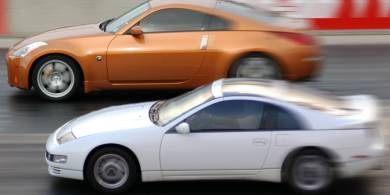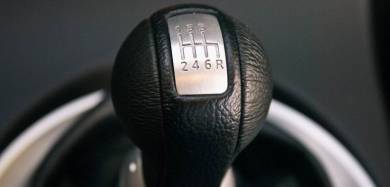![]()
![]()
![]()
![]()
![]()
![]()
![]()
![]()

![]()

![]()
![]()
|
Drag Racing Tips and Techniques
Drag racing is best described as a tournament consisting of a two-car straight-line race. It is an all-out acceleration contest from a standing start between two vehicles over an exact distance. Professional drag strips are available for public use all over the world, but the illegal street racing culture has popularized drag racing nowadays in such a way that most common folks think of drag racing as a bunch of sticker-clad street cars causing mayhem at night. Well, whatever gets you going, it is a fact that the launch becomes the deciding factor in any drag race where the machinery is equal.
The race may depend on the launch, but it also depends on how much you know about your car. Every car has its own launching method, and the techniques detailed here will help you determine what is best for your car. All you need to do is experiment with your car, and be aware of any changes to your setup, tarmac quality or weather conditions that could change what you thought was the best method. Pretty much the only hard and fast rule is to practice in various conditions. Drag racing is definitely hard on your car, but to become consistent in your driving, you will have to sacrifice some hard-earned cash for tires, repairs and modifications. The way you launch your car is based mainly on two variables--the type of transmission in your car (manual or automatic), and the drive wheels (front-wheel-drive, rear-wheel drive or all-wheel-drive). We will take a look at managing a manual transmission first. With a stick shift, the main aim is to avoid excessive wheelspin by pressing the throttle too much, but also avoid bogging down the motor by pressing the throttle too little. The driver has to get the throttle input just right, like in that Goldilocks fairytale. Each car engine has a different rpm range in which it will produce the most power. The trick is to keep the engine in this sweet spot from the moment you cross the starting line all the way to the finish line, without any of this peak power being wasted. Launching a car hard from a dead stop is accomplished by slipping the clutch and spinning the tires, both within reason. Power is lost here, but most engines have narrow power and torque bands, so the fastest launch will include wheelspin and slipping the clutch. The only way to find out how much slipping would be just right is to experiment at the track, holding the throttle at various rpm levels at launch to see how much juice is needed for the quickest start. While playing with the clutch and throttle, use the parking brake to keep your car from rolling. This is the only way to keep your car stationary while you work the clutch with the left foot and the throttle with the right. You then release the parking brake as you launch. Some people may say a manual benefits from powershifting during
a race, which is to keep the throttle floored between shifts.
It is not a good idea for a beginner, since a ill-timed shift
can cause your engine to over-rev and inflict permanent damage.
In general, automatic transmissions are known as being more useful for lazy commuters than for hardcore racers. But it may be surprising for some to know that many pro drag-racing cars have heavy-duty auto gearboxes. That's because the brake-torque launch is an automatic specialty. This launch involves keeping the car stationary by flooring the brakes with the left foot, while using the right foot to rev up the engine against the torque converter. In technical terms, this preloads the entire drivetrain with the stress of a launch, allowing the engine to rev closer to its power and torque peaks at the starting line. Brake-torquing is also beneficial for turbocharged engines as it allows boost to build up before the launch, reducing turbo lag. The only problem is that there is a lot of stress on the transmission, and the consequent heat build-up can destroy your automatic gearbox. Unless your car has too much power for the tires to handle, a brake-torque launch usually will not spin the wheels. This is because the automatic transmission absorbs the shock by design, and brake-torquing actually reduces stress on the rest of the drivetrain. Instead of a sudden massive load, the drivetrain has the torque applied slower instead of one huge jolt. If your car has power brakes, you could apply the brake-torquing technique even better. At the starting line, shift your auto gearbox into neutral and floor the brake pedal with your left foot. Rev the engine once and quickly get off the throttle. You will feel the brake pedal sink further to the floor. This greatly increases the braking force. Now shift back into gear. You will now be able to rev up the engine even higher against the torque converter.The downfall of standard automatics is their easy-going nature while shifting, so you lose power during the actual race, where a manual would have allowed for more aggressive upshifts. However, the shift points of an automatic can be professionally modified for drag racing, and some new automatics even allow for manual shifting or have a sport setting for quicker gear changes. In fact, you could shift up through the gears even on most conventional automatics for a little more oomph. The drive wheels make a big difference in the way your car launches. Most front-wheel-drive cars lose traction and spin the front wheels more easily because the sudden acceleration transfers weight off of the front wheels toward the rear. This is the reason why front-wheel-drive pro drag-racing cars have wheelie bars installed at the back, to keep the front end pressed to the ground. You have to launch using less throttle than you would with a rear-wheel-drive, to avoid excessive wheelspin, and then you gradually apply more throttle as you gain traction. A front-driver with a limited-slip differential, like the Acura Integra Type-R and the later-model Dodge SRT-4, also reduces torque steer so you don't pull left or right under full throttle. Rear-wheel-drive cars have more traction off the line, as the weight transfers toward the rear during acceleration. You need to slip the clutch more to keep the engine from bogging down because spinning the tires isnít that easy, especially if you are low on power but have wide rear tires. Also watch out for wheel hop on older American V8 monsters like the Camaro and the Fox-body Mustang. These cars also have tons of power so wheelspin is possible, but be careful not to waste time doing an unintended burnout at the starting line. Recently, all-wheel-drive cars have made inroads in the sport compact market with the likes of the Mitsubishi Lancer Evo and the Subaru WRX. These high-tech four-wheel-driven machines often have more traction than they can use, so a nearly full-throttle launch is possible without a hint of wheelspin. Generous throttle application is needed since bogging down the motor is even easier in these cars. But these perfect-looking launches are very hard on the clutch and drivetrain. These cars actually last longer for drag-race duty when equipped with an automatic, and the easiest of all to launch, but the most hardcore of these rally-bred cars only come with a manual in keeping with their corner-carving tradition.After figuring out the best way to launch your type of car, you then fine-tune your technique to factor in environmental conditions like the track surface, the weather and ambient temperature, the state of your tires and the contents of your stomach (stay away from baked beans before a race). Learn the handling quirks of your own car, and practice in various conditions. Vary only one parameter at any given time--amount of launch revs, sweet spot of the clutch, etc. After your now-perfect launch, just keep the steering wheel straight, shift just before the tach hits redline, and floor it after every shift. With an automatic, shifting it manually can fractionally improve your time, but just leaving it in Drive probably will be better for beginners. After crossing the finish line, just slowly and gradually apply the brakes and take in the rush that you just experienced. |
![]()
![]()
![]()
© Copyright 2025 Csruniforms.com All rights reserved.
Unauthorized duplication in part or whole strictly prohibited by international
copyright law.
![]()






